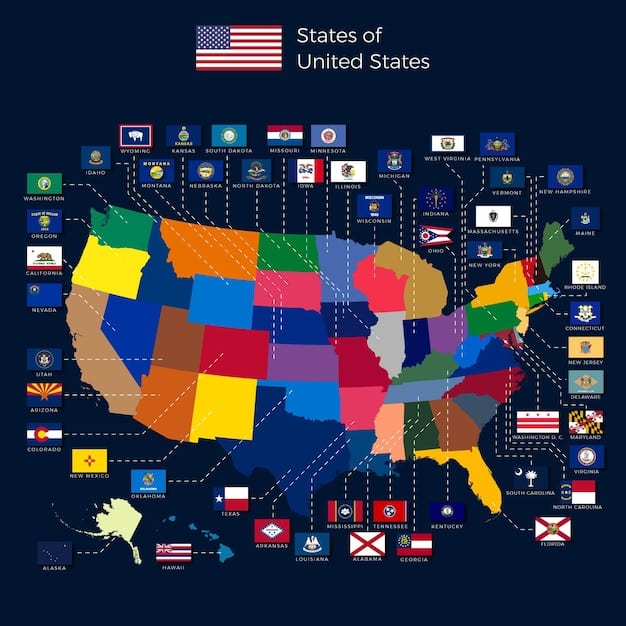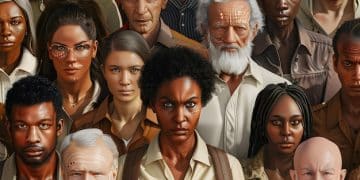Decoding American Vernacular: Latest Trends & What’s Out

Decoding the Latest Trends in American Vernacular: What’s In, What’s Out explores the ever-evolving language landscape of the United States, identifying emerging slang, phrases, and cultural expressions while highlighting those that have faded into obsolescence.
The American vernacular is a constantly shifting landscape, reflecting changes in culture, technology, and social attitudes. Decoding the Latest Trends in American Vernacular: What’s In, What’s Out, helps navigate this dynamic environment by pinpointing which phrases and words are currently popular and which have fallen out of favor.
The Ever-Changing Landscape of Language
Language is a living entity, constantly evolving and adapting to the needs and experiences of its users. The American vernacular, in particular, is a rich tapestry woven from regional dialects, cultural influences, and technological advancements. Understanding these trends requires a keen ear and an awareness of the social forces that shape our communication.
So, what exactly drives these linguistic shifts? Let’s explore the key factors that contribute to the ever-changing nature of American vernacular.
The Influence of Social Media
Social media platforms like TikTok, Twitter, and Instagram serve as incubators for new slang and expressions. Trends can emerge and spread rapidly, shaping the way people communicate online and offline.
Pop Culture’s Role
Popular movies, music, and television shows often introduce new words and phrases into the vernacular. These expressions can become widely adopted, influencing the way people talk and write.
- Regional Dialects: Different regions of the United States have their own unique dialects, which contribute to the diversity of American vernacular.
- Cultural Influences: The American vernacular is constantly being enriched by the languages and cultures of immigrant communities.
- Technological Advancements: The rise of the internet and social media has accelerated the pace of linguistic change, leading to the creation of new words and phrases.
The American vernacular mirrors the diverse nature of American society, reflecting a myriad of voices that shape the way Americans communicate.

Current Slang and Emerging Phrases
Keeping up with the latest slang can feel like a full-time job. New words and phrases seem to appear overnight, often leaving those who aren’t “in the know” feeling lost. But fear not; we’re here to provide a guide to the current slang and emerging phrases that are shaping American vernacular today.
From terms related to online culture to expressions of emotion, here’s a look at what’s trending right now.
Gen Z’s Influence on Language
Gen Z, known for their digital fluency and social media savviness, is a major driver of linguistic innovation. Their slang often reflects their unique perspectives and experiences.
Examples of Current Slang
Here are a few examples of slang terms that are currently popular in American vernacular:
- Rizz: Short for charisma, “rizz” refers to someone’s ability to attract or seduce others.
- Slay: To do something exceptionally well or to succeed in a spectacular way.
- Bussin’: Used to describe something that is incredibly delicious or high-quality.
Each generation leaves its mark on the American vocabulary and helps the words of the era evolve.
Terms That Have Faded Away
As new slang and phrases emerge, others inevitably fade into obscurity. These outdated terms can sound awkward or out of touch when used in contemporary conversation. Understanding which words and phrases are no longer in vogue is just as important as knowing the latest trends.
Let’s take a trip down memory lane and look at some terms that have lost their luster.
The Evolution of Language Over Time
Language is constantly evolving, and words that were once popular can quickly become outdated. This reflects changes in culture, technology, and social attitudes.
Examples of Outdated Terms
Here are a few examples of words and phrases that are no longer commonly used in American vernacular:
- Rad: Popular in the 1980s, “rad” was used to describe something that was cool or excellent.
- Groovy: A term from the 1960s and 1970s, “groovy” meant fashionable or exciting.
- Far out: Another term from the 1960s, “far out” was used to describe something that was unconventional or mind-blowing.
The passage of slang terms highlights the always changing landscape of American English.
Regional Variations in American Vernacular
American vernacular is not a monolith. Different regions of the United States have unique dialects and expressions that reflect their local culture and history. Exploring these regional variations can provide insights into the diversity of American language.
Let’s take a look at some notable regional differences in the way Americans speak.
The Influence of Location on Language
Where you live can have a significant impact on the way you speak. Regional dialects often carry their own distinct vocabulary and pronunciation patterns.
Examples of Regional Expressions
Here are a few examples of regional expressions that are unique to certain parts of the United States:
- Y’all (Southern): A contraction of “you all,” used as a plural form of “you.”
- Hella (Northern California): Used as an intensifier, similar to “very” or “really.”
- Wicked (New England): Another intensifier, meaning “very” or “extremely.”
Regional language variations showcase the dynamic and varied nature of US slang and culture.

How Technology Shapes Vernacular
Technology has revolutionized the way we communicate, and its impact on American vernacular is undeniable. From internet slang to social media abbreviations, technology has given rise to a whole new lexicon.
Let’s examine the ways in which technology influences the language Americans use every day.
The Rise of Internet Slang
The internet has spawned its own unique language, characterized by abbreviations, acronyms, and emojis. These online expressions have gradually made their way into offline conversation.
Examples of Tech-Related Terms
Here are a few examples of tech-related terms that are commonly used in American vernacular:
- LOL: An abbreviation for “laughing out loud,” used to indicate amusement.
- BRB: An abbreviation for “be right back,” used to indicate a temporary absence.
- IMO: An abbreviation for “in my opinion,” used to express a personal viewpoint.
Technology reshapes how people interact and communicate online.
Predicting Future Trends in Vernacular
Predicting the future of language is no easy task, but we can make educated guesses based on current trends and social forces. The American vernacular will likely continue to evolve rapidly, driven by technology, culture, and social change.
Let’s explore some possible future trends in American vernacular.
Future Changes
As technology continues to advance and social attitudes shift, we can expect to see new words and phrases emerge that reflect these changes.
The Influence of AI on Language
Artificial intelligence is already beginning to influence language, and its impact will likely grow in the years to come. AI-powered technologies could generate new words and phrases or alter the way we use existing ones.
- Continued Digital Influence: As technology evolves, online expressions will become increasingly integrated into everyday language.
- Greater Cultural Diversity: American vernacular will continue to be enriched by the languages and cultures of immigrant communities.
- Increased Fluidity: Language will become even more fluid and adaptable, reflecting the fast-paced nature of modern life.
The future of American vernacular promises to be dynamic, influenced by social trends and technological advancement.
| Key Concept | Brief Description |
|---|---|
| 🗣️ Emerging Slang | New terms like “rizz” and “slay” are gaining popularity. |
| ⏳ Faded Terms | Old slang, such as “rad” and “groovy,” is becoming outdated. |
| 📱 Tech Influence | Internet slang and abbreviations are widely used. |
| 🌍 Regional Dialects | Variations like “y’all” in the South are still common. |
FAQ
▼
American vernacular encompasses the everyday language used by Americans. It includes slang, regional dialects, and informal expressions that shape how people communicate in various social settings.
▼
Slang changes quickly due to cultural shifts, technological advancements, and social media trends. As new ideas and expressions emerge, older ones often fade away, driving continuous language evolution.
▼
Social media platforms act as incubators for new slang. Trends spread quickly online, impacting both online and offline conversations. Platforms like TikTok and Twitter play a significant role.
▼
Examples of outdated words include “rad” (cool in the 80s) and “groovy” (fashionable in the 60s/70s). These terms are no longer commonly used, indicating the ever-evolving nature of language.
▼
Regional dialects vary considerably. In the South, “y’all” is common, while Northern California uses “hella.” New England might say “wicked.” These differences reflect each region’s unique culture.
Conclusion
Understanding the dynamics of American vernacular is crucial for navigating the ever-evolving landscape of language and culture. By staying attuned to current trends, recognizing outdated terms, and appreciating regional diversity, we can communicate more effectively and connect with others in meaningful ways.





